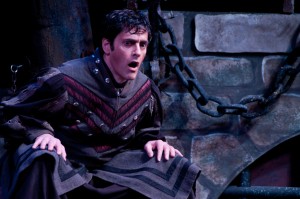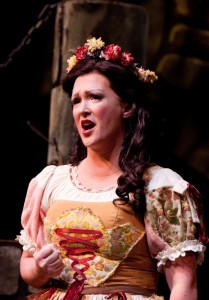There is a certain feeling of excitement mixed with fear when I go to see an operetta by W. S. Gilbert and Sir Arthur Sullivan. My memories of past performances and great familiarity with the words and music lead me to expect an enormous enjoyment, and my fear is that with such high anticipations I will be disappointed in the result. For two reasons this mixed feeling was especially present the afternoon of February 5, 2011 as I sat in the theatre at Yerba Buena Gardens in San Francisco and waited for the opening chords of the overture.
Long ago, when I was a freshman at Antioch College in Yellow Springs, Ohio, I was one of the townsmen in our college production of Yeomen of the Guard. It was not only the first G & S I performed in, it was the first time in my life that I had appeared on a stage where people in the audience had paid money to attend. Would the performance I was about to hear live up to my golden haze of long ago memories?
Also I was accompanied by my friend Letha Ann who is almost as much of an opera nut as I am (and who has a much better musical ear) but who was not at all familiar with Gilbert and Sullivan. When one introduces two friends, one always hopes they will like each other – would this performance satisfy her sophisticated taste for opera?
I began to relax with the opening aria. Cary Ann Rosko was a most believable Phoebe as she sang,
‘Tis but a little word – “heigho!”
So soft, ’tis scarcely heard – “heigho!”
An idle breath –
Yet life and death
May hang upon a maid’s “heigho!”
Then a dozen Yeomen marched in and sang,
In the autumn of our life,
Here at rest in ample clover,
We rejoice in telling over
Our impetuous May and June.
in perfectly articulated four-part harmony, followed by Dame Caruthers’ (Katherine Schumacher) gruesome
The screw may twist and the rack may turn,
And men may bleed and men may burn,
O’er London town and its golden hoard
I keep my silent watch and ward!
All previous Yeomen were forgotten. I knew I was in for a first-rate performance. And my concern for my friend liking my opera evaporated at the intermission when she said, “Wow! Superb!”
The set by Peter Compton and the lighting by Robert Ted Anderson were fantastic. When the whole stage was lighted, the background was a wonderful representation of the exterior of the Tower of London.
However, when only a small part of the stage was lighted dimly, one had the impression that the scene was now inside the tower.
Unlike all the other G & S operas, The Yeomen of the Guard has real people as its characters. And the particular actors I saw brought out this realism. This is particularly true of the jester Jack Point (Chris Uzelac) and his Merry Maid Elsie Maynard (Jennifer Ashford).
Notes: (1) Lamplighters casts two people in each of the major roles, but most of their publicity photos were taken at a particular rehearsal, so that some of the singers in the photos are not the people I saw. For this reason I have identified singers in both the text (the person I saw) and in the figure captions. (2) If you are not familiar with the story of Yeomen, I suggest you take a moment to read the excellent Wikipedia synopsis before continuing with this review.
Jack Point is much more introspective than better known jesters in opera such as Rigoletto and Pagliacci, and Chris Uzelac brings out both the jester and the human being in two of his songs:
For he who’d make his fellow fellow fellow creatures wise, Must always gild the philosophic pill
and even more in Act II,
Though your wife ran away with a soldier that day,
And took with her your trifle of money;
Bless your heart, they don’t mind –
They’re exceedingly kind –
They don’t blame you – as long as you’re funny!
He and Jennifer Ashworth as Elsie Maynard do a wonderful job with the ballad, A Merry Man and his Maid. In Act I they sing all four verses with lilting gaiety, even such lines as
It is sung to the knell
Of a churchyard bell,
And a doleful dirge, ding dong, O!
as if they have foreknowledge of the final happy couplet,
His pains were o’er, and he sighed no more,
For he lived in the love of a ladye!
In contrast at the end of Act II they sing a bitter reprise at the end of the Finale to the opera. Point sings the same words,
It’s a song of a merryman, moping mum,
Whose soul was sad, and whose glance was glum,
Who sipped no sup, and who craved no crumb,
As he sighed for the love of a ladye.
but oh, what a difference in the way he sang them. Elsie, on the other hand, was cheerful both times, but changed her words. In Act I she sang,
It’s the song of a merrymaid, peerly proud,
Who loved a lord, and who laughed aloud
At the moan of the merryman . . .
But in the Finale she showed some compassion for Jack Point by singing,
It’s the song of a merrymaid, nestling near,
Who loved her lord, but who but dropped a tear
At the moan of the merryman . . .

Phoebe (Jessie Bond) distracts Wilfred as she steals his key; from the opening night cast, October 3, 1888
This change in Elsie’s lyrics was an afterthought of Gilbert. On opening night in 1888 and all through the original run of 423 performances, she sang the reprise exactly the same as the original; it was only during the revival in 1897 that the change was made.

Jack Point (Chris Uzelac), Elsie Maynard (Amy Foote) and Colonel Fairfax(Michael Imbimbo) Photo by Charles Martin
After singing the reprise, Jack Point falls to the floor and it is not clear whether or not he has literally died of a broken heart. Gilbert himself apparently wanted it this way. The actual stage direction in the original edition of the text and in all subsequent editions published during his lifetime was, “Fairfax embraces Elsie as Point falls insensible at their feet.”

Original Jack Point (L: George Grossmith at the Savoy; R: Henry Lytton with the road company); photos from the web
It is reported that George Grossmith (Sr.) who played the part in the original cast would wiggle his toes as a signal that he was only in a faint. On the other hand, Henry Lytton who played it for a touring company, stated that, “Jack Point should die and the end of the opera should be a tragedy.” I was glad to see that the Lamplighters respected Gilbert’s ambiguity; Chris Uzelac gave no clear indication whether he was alive or dead – but I’m happy to report that whichever it was, he recuperated in time to take an enthusiastic curtain call.
There is one more opportunity to see this excellent production of The Yeomen of the Guard. It will be playing at the Bankhead Theater in Livermore on Saturday and Sunday, February 19 and 20, 2011. Call 925-373-6800 for details or visit www.lamplighters.org.
The Opera Nut
Except where otherwise noted, photos are by Greta Schnetzier
This review by Philip G Hodge appeared in sanfranciscosplash.com on 2/11/11.






